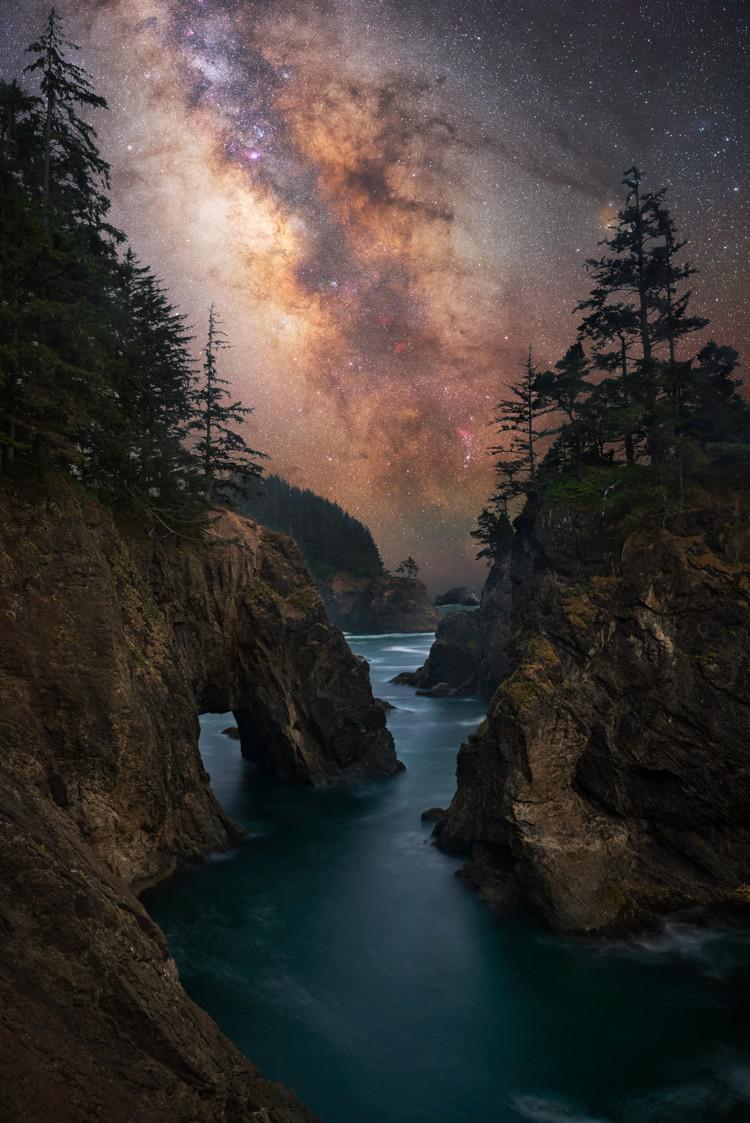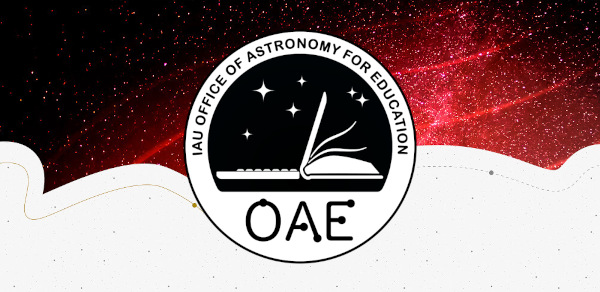This page describes an image Oregon Coast
Caption:
Honourable mention in the 2022 IAU OAE Astrophotography Contest, category Still images of celestial patterns:.
This image features the Milky Way, our home galaxy, over Oregon, USA, as seen in July 2021. It is obviously a composite because the stars are not reflected in the water. Still, it is nicely composed to suggest a similarity between the stream of water on Earth and the (mirrored) stream of stars in the sky.
The Milky Way clearly dominates the sky in this image. As a prominent feature in the sky, the Milky Way has been associated with the religions and mythologies of many cultures. The best-known association from Greek folklore “explains” it as a stream of divine milk from the mighty mother goddess Hera, whose husband god Zeus frequently misbehaved (as he did in this case, causing this accident). Greek mythology, on the other hand, considered it to be the path of the souls, while ancient Greek science suggested several scientific explanations, all of which turned out to be false.
The Ojibwe in North America, who live to the east of Oregon where this photograph was taken, also consider the Milky Way a Path for Spirits and a River of Souls. Looking at the foreground of the picture, this belief is even more understandable; it looks as if the rivers of Earth and heaven merge at the horizon.
The prominent feature in the middle of the image is the dark region called the Pipe Nebula in the Milky Way. The smoke of this pipe goes to the right and ends almost at a treetop, where we find the orange star Antares in the heart of the Scorpion.
In the middle of the image, below the Pipe, there is a huge dark area in the Milky Way with two prominent red spots. These spots are hydrogen clouds called the Cat’s Paw and the Lagoon, but in this image they look like the red eyes of great Manitou, the Great Spirit of the Iroquois Native Americans. The constellation of Sagittarius in this area is not recognisable because the image of the Milky Way is highly processed in order to display these dark features that are invisible to the naked eye.
Credit:
Marcin Zajac/IAU OAE
DOI: 10.5281/zenodo.7425585
Related glossary terms:
Dust
, Dust Cloud
, Interstellar Extinction
, Milky Way
Categories:
Milky Way and Interstellar Medium
, Naked Eye Astronomy
License: Creative Commons Attribution 4.0 International (CC BY 4.0) Creative Commons Attribution 4.0 International (CC BY 4.0) icons
The media file captions presented on the OAE website were written, translated and reviewed by a collective effort from the OAE, the OAE Centers and Nodes, the OAE National Astronomy Education Coordinators (NAECs) and other volunteers. You can find a full list of credits for our translation project here. All media file captions are released under a Creative Commons CC BY-4.0 license and should be credited to "IAU OAE". The media files themselves may have different licenses (see above) and should be credited as listed above under "credit".
Captions in Different Languages:
Caption: Lobende Erwähnung im IAU OAE Astrofoto-Wettbewerb 2022, Kategorie Weitwinkelaufnahmen von Himmelsmustern.
Dieses Bild zeigt unsere Heimatgalaxie, die Milchstraße, in einer Aufnahme vom Juli 2021 über Oregon in den USA. Es handelt sich offensichtlich um ein Kompositbild, da sich die Sterne nicht im Wasser spiegeln. Dennoch ist es sehr schön zusammengestellt, um eine Ähnlichkeit zwischen dem strömenden Wasser auf der Erde und dem (gespiegelten) Strom der Sterne am Himmel zu suggerieren.
Die Milchstraße dominiert eindeutig den Himmel in diesem Bild. Als auffälliges Merkmal am Himmel steht die Milchstraße mit den Religionen und Mythologien vieler Kulturen in Verbindung. Die bekannteste Assoziation aus der griechischen Folklore "erklärt" sie als einen Strom göttlicher Milch der mächtigen Göttin Hera, deren Gatte, der Gott Zeus, sich häufig danebenbenahm (wie auch im Vorfeld des Unfalls, der zur Entstehung der Milchstraße führte). Unter griechischen Denkern galt die Milchstraße als Pfad der Seelen, während die antike griechische Wissenschaft eine Reihe von Erklärungen vorschlug, die sich allesamt als falsch erwiesen.
Die Ojibwe in Nordamerika, die östlich von Oregon leben, wo dieses Foto aufgenommen wurde, betrachten die Milchstraße ebenfalls als einen Weg für Geister und einen Fluss der Seelen. Betrachtet man den Vordergrund des Bildes, wird dieser Glaube noch verständlicher: Es sieht so aus, als ob die Flüsse der Erde und des Himmels am Horizont zusammenfließen.
Die auffällige Struktur oberhalb der Bildmitte ist eine Dunkelwolke in der Milchstraße, die als Pfeifennebel bezeichnet wird. Der Rauch dieser Pfeife zieht nach rechts und endet fast in einer Baumkrone, wo wir den orangefarbenen Stern Antares im Herzen des Skorpions finden.
In der Mitte des Bildes, unterhalb der Pfeife, befindet sich ein großer dunkler Bereich in der Milchstraße mit zwei auffälligen roten Flecken. Bei diesen Flecken handelt es sich um Wasserstoffwolken, die als Katzenpfoten- und Lagunennebel bezeichnet werden, aber auf diesem Bild sehen sie aus wie die roten Augen des großen Manitou, des Großen Geistes der Irokesen. Das Sternbild Schütze ist in diesem Bereich nicht zu erkennen, da das Bild der Milchstraße stark bearbeitet wurde, um die dunklen Merkmale darzustellen, die mit bloßem Auge nicht sichtbar sind.
Credit: Marcin Zajac/IAU OAE
Related glossary terms: Dust Cloud , Interstellare Extinktion , Milchstraße , Staub Caption translation status: Not yet approved by a reviewer
Caption translators: Carolin Liefke
Caption: Menzione d'onore al concorso di astrofotografia IAU OAE 2022, categoria Immagini fisse di modelli celesti:.
Questa immagine mostra la Via Lattea, la nostra galassia natale, sopra l'Oregon, negli Stati Uniti, vista nel luglio 2021. Si tratta ovviamente di una composizione, perché le stelle non si riflettono nell'acqua. Tuttavia, è ben composta per suggerire una somiglianza tra il flusso d'acqua sulla Terra e il flusso (riflesso) di stelle nel cielo.
La Via Lattea domina chiaramente il cielo in questa immagine. Come elemento di spicco del cielo, la Via Lattea è stata associata alle religioni e alle mitologie di molte culture. L'associazione più nota è quella del folklore greco, che la "spiega" come un flusso di latte divino della potente dea madre Era, il cui marito, il dio Zeus, si comportava spesso male (come in questo caso, causando questo incidente). La mitologia greca, invece, lo considerava il percorso delle anime, mentre la scienza greca antica proponeva diverse spiegazioni scientifiche, tutte rivelatesi false.
Anche gli Ojibwe del Nord America, che vivono a est dell'Oregon, dove è stata scattata questa fotografia, considerano la Via Lattea un sentiero per gli spiriti e un fiume di anime. Osservando il primo piano dell'immagine, questa credenza è ancora più comprensibile: sembra che i fiumi della Terra e del cielo si fondano all'orizzonte.
L'elemento di spicco al centro dell'immagine è la regione scura chiamata Nebulosa della Pipa nella Via Lattea. Il fumo di questa pipa va verso destra e termina quasi in cima a un albero, dove troviamo la stella arancione Antares nel cuore dello Scorpione.
Al centro dell'immagine, al di sotto della Pipa, c'è un'enorme area scura nella Via Lattea con due macchie rosse prominenti. Queste macchie sono nubi di idrogeno chiamate Zampa di Gatto e Laguna, ma in questa immagine sembrano gli occhi rossi di Manitou, il Grande Spirito dei nativi americani irochesi. La costellazione del Sagittario in quest'area non è riconoscibile perché l'immagine della Via Lattea è altamente elaborata per mostrare queste caratteristiche scure, invisibili ad occhio nudo.
Credit: Marcin Zajac/IAU OAE
Related glossary terms: Estinzione interstellare , Nube di polvere , Polvere , Via Lattea Caption translation status: Approved by a reviewer
Caption translators: Giuliana Giobbi
Caption reviewers: Rodolfo Canestrari









